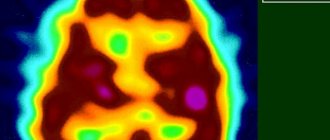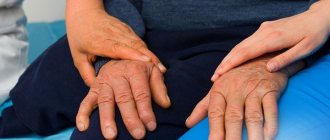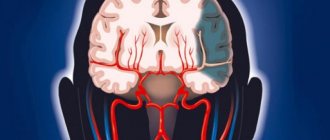Dementia with Lewy bodies (DLB) is a progressive neurodegenerative disease, most often onset in old age and manifested by increasing cognitive decline, parkinsonian symptoms, psychotic disorders and autonomic dysfunction. The true scientific history of DTL begins in the late 70s of the last century. It is associated with the name of the Japanese researcher K. Kosaka, who described several patients with dementia in whom Lewy bodies were found in the cerebral cortex at autopsy. In connection with DLB, one cannot help but recall F. Lewy himself, the famous German pathologist, who in the 30s of the last century, fleeing the Nazis, moved to the USA. He made the main discovery of his life in 1912 at the age of 27, working in Breslau (Wroclaw), describing eosinophilic inclusions in brain neurons in patients with Parkinson's disease. F. Lewy discovered intracellular inclusions in the motor nucleus of the vagus nerve and Meynert's nucleus, but not in the substantia nigra, the lesion of which is currently associated with the development of major motor disorders. This task was completed by another young scientist - our compatriot K.N. Tretyakov, who in 1917, while on an internship at the Salpêtrière clinic in Paris, described similar inclusions in the cells of the substantia nigra and proposed calling them “Lewy bodies.”
Etiology
As with AD3, most cases of DLB are sporadic; however, it appears that familial cases are more common in DLB than in AD or vascular dementia. Approximately half of patients with DLB have one or more first-degree relatives with dementia or parkinsonism. In familial cases of DLB, clinical polymorphism is observed, which complicates medical genetic analysis. Only in a relatively small proportion of familial cases of DLB, genetic mutations were identified: triplication of the synuclein gene on chromosome 4, mutations in the LRRK2 gene on chromosome 12, gene changes on the short arm of chromosome 2 (2q35-36), the functional purpose of which remains unclear.
Diagnosis, prognosis and treatment
The diagnosis is made clinically, but the sensitivity and specificity of diagnosis are low. The diagnosis is considered (taken into account) as probable in the presence of 2-3 signs - fluctuations of attention, visual hallucinations and parkinsonism - and as possible if only one of them is identified. Evidence supporting the diagnosis includes recurrent falls, syncope, and increased sensitivity to antipsychotic medications. The overlapping symptoms of Lewy body dementia and Parkinson's disease can make diagnosis difficult. When the motor deficits associated with Parkinson's disease precede and are more severe than the cognitive impairment, a diagnosis of Parkinson's disease is usually made. If early cognitive impairment and behavioral changes predominate, a diagnosis of dementia with Lewy bodies is made.
CT and MRI do not reveal characteristic changes, but are initially useful in identifying other causes of dementia. Positron emission tomography with fluorine-18-labeled deoxyglucose and single photon emission CT (SPECT) with 123I-FP-CIT (Nw-fluoropropyl-2b-carbomethoxy-3b-[4-iodophenyl]-tropane), a fluoroalkyl derivative of cocaine, may be useful in identification of dementia with Lewy bodies, however, is not a routine research method. A definitive diagnosis requires an autopsy of brain tissue.
Dementia with Lewy bodies is a progressive disease with a poor prognosis. Treatment is mainly supportive. Rivastigmine 1.5 mg orally as indicated, titrated up to 6 mg as needed, may improve cognitive impairment. Other cholinesterase inhibitors may also be useful. Approximately 1/2 of patients respond to treatment of extrapyramidal symptoms with antiparkinsonian drugs, but the psychiatric manifestations of the disease worsen. If the use of antiparkinsonian drugs is necessary, preference should be given to levadopa.
Traditional antipsychotics, even in very low dosages, lead to a sharp worsening of extrapyramidal symptoms, and it is better to abandon them.
Neuromorphology
Macroscopically, in most patients with DLB, as in many other neurodegenerative diseases, diffuse brain atrophy is detected with expansion of the cortical grooves and lateral ventricles, although on average it is less pronounced than in AD.
The development of dementia in DLB is associated with a degenerative process in the neocortex and limbic cortex, primarily in the anterior cingulate, parahippocampal gyrus, frontal and parietal cortices. As modern methods of functional neuroimaging show, already at an early stage there is a decrease in the function of the occipital cortex, which can serve as one of the differential diagnostic signs distinguishing DLB from AD. At the same time, atrophy and microscopic signs of degeneration, including Lewy bodies, in the occipital cortex are very moderately expressed. Thus, dysfunction of the occipital cortex, which may be associated with the early development of visuospatial impairment, appears to be associated with impaired neurochemical processes (eg, cholinergic denervation). The development of parkinsonism, observed in the majority of patients with DLB, is associated with the involvement of the substantia nigra and striatum in the degenerative process, and sleep disorders with damage to brain stem structures. The development of autonomic dysfunction is explained both by damage to the stem nuclei and by the involvement of peripheral autonomic structures, which already at an early stage of the disease leads to autonomic denervation of the heart.
Dementia in Parkinson's disease
In Parkinson's disease dementia (as opposed to Lewy body dementia), the cognitive impairment leading to dementia typically begins 10 to 15 years after the onset of uncontrolled motor symptoms.
Parkinson's disease dementia can affect several cognitive domains, including attention, memory, visuospatial orientation, and constructive and executive functions. Executive dysfunction tends to occur earlier and more frequently in Parkinson's disease dementia than in Alzheimer's disease.
Psychiatric symptoms (eg, hallucinations, delusions) are less frequent and/or less severe than in dementia with Lewy bodies.
In Parkinson's disease dementia, postural instability and gait abnormalities are more common, motor function declines more quickly, and falls are more common than in Parkinson's disease without dementia.
Clinic
The range of clinical manifestations of DLB is very wide and includes cognitive, psychotic, motor disorders, autonomic dysfunction, sleep and wakefulness disorders. Cognitive decline is an obligate manifestation of DLB. Most cases of DLB are characterized by a unique neuropsychological profile, in which subcortical and cortical disorders are intertwined. At the early stage, disorders of the neurodynamic and regulatory type dominate, the leading of which are attention disorders, and both concentration and stability of attention suffer. DLB is also characterized by the early and rapid development of visuospatial impairments, which are one of the main “calling cards” of the disease.
At first, difficulties in performing tests are explained by a violation of attention, planning and execution of complex constructive tasks, and only partly gnosis. But as the disease progresses, disorders associated with dysfunction of visual associative pathways quickly appear. Over time, errors in visual recognition of objects, familiar objects, and finally close relatives appear. Moreover, self-identification also suffers - seeing his reflection in the mirror, the patient (usually in the advanced stages of DLB) mistakes him for another person (mirror symptom). Violation of regulatory (frontal) and visuospatial functions is one of the main prerequisites for the early appearance of visual hallucinations. In this case, memory remains more intact and is characterized not by a defect in memorization, consolidation and storage, but rather by a violation of the search and reproduction of traces, which is associated with dysfunction of the frontal parts and the relative intactness of the medial parts of the temporal lobes. Often, relatives are surprised to hear from a patient in moments of enlightenment a story about the events of a past life with details that they themselves have long forgotten.
Another characteristic feature of the mental status is fluctuations, characterized by transient episodes of decreased attention and activity with unspontaneity, unresponsiveness, and sometimes confusion. Such episodes of deterioration can last from several minutes to several hours and are often mistakenly regarded as manifestations of cerebrovascular insufficiency or as an epileptic phenomenon. Fluctuations in mental status also occur in other forms of dementia - vascular dementia or AD, but only in DLB they occur at an early stage of the disease. With DLB, longer-term fluctuations often occur, characterized by the presence of “bad” and “good” days (“second-order” fluctuations) or multi-day episodes of decompensation of the main manifestations of the disease (“third-order” fluctuations). Episodes of decompensation are often the result of inadequate therapy, dehydration, intercurrent illnesses, overheating, but sometimes they also occur spontaneously. In severe cases, they can result in death; in milder cases, they can result in restoration of the previous functional state. But most often, recovery is partial, which moves the patient “one step higher” in the progressive course of the disease.
Psychotic disorders are another typical, diagnostically important feature of DLB, which often has a dramatic impact on the subsequent course of the disease. Sometimes visual hallucinations, which are considered the most characteristic variant of psychotic disorders in DLB, appear already in the prodromal phase of the disease, when there is still no disturbance in daily activities that allows one to diagnose dementia. The spectrum of psychotic disorders in DLB includes, along with visual hallucinations, the so-called extracampal phenomena (feelings of the presence of a stranger or someone passing by), hallucinations of other modalities (auditory, tactile, somatic), illusions, delusional syndromes (often related in content to hallucinations). ), identification disorder syndromes (for example, Capgras syndrome), delirium.
The spectrum of psychopathological disorders should be supplemented by anxiety and depression, which often appear already at the prodromal stage of the disease, but persist at later stages, as well as such conditions as apathy, agitation, disinhibition, which, as a rule, appear at a later stage of the disease, significantly complicating nursing.
Motor disorders in DLB are characterized by symptoms of parkinsonism. In the early stages, extrapyramidal pathology occurs only in 50% of patients and is often represented by relatively mild symptoms. This often misleads a neurologist if he superficially examined the patient and did not pay attention to pronounced cognitive and neuropsychological disorders. As a result, he mistakenly diagnoses the early stage of PD and, in accordance with this, prescribes dopamine agonists, anticholinergics, etc., which can provoke psychotic disorders in this category of patients. Next, the patient is transferred to a psychiatric institution, where he is prescribed antipsychotics for psychosis, the use of which even in minimal doses in patients with DLB can lead to a sharp deterioration of the condition such as an akinetic crisis, ending in death in at least a third of patients.
As the disease progresses, the incidence of extrapyramidal symptoms increases to 80%. Parkinsonism in DLB is characterized by a more frequent left-sided onset, early development of axial disorders (hypomimia, postural instability with frequent falls, early walking impairment with freezing, truncal bradykinesia, camptocormia, dysphonia or dysarthria). Disturbances in sleep and wakefulness can manifest themselves in patients with DLB long before the appearance of other symptoms of the disease. This primarily refers to behavioral disorder (“psychomotor agitation”) during the rapid eye movement sleep phase. Such disturbances may precede other manifestations of the disease by several decades. Another common symptom is daytime sleepiness.
The early development of autonomic dysfunction is another of the most characteristic manifestations of DLB, associated with damage to the stem autonomic structures, the lateral horns of the spinal cord, and the peripheral autonomic system. The most common autonomic manifestations are neurocardiovascular instability with orthostatic hypotension and a tendency to faint, neurogenic urinary disorders (frequent imperative urination, nocturia, subsequent partial urinary retention or incontinence), gastrointestinal dysfunction (gastroparesis, constipation or diarrhea).
Symptoms and signs
Initial cognitive impairment is similar to that found in other types of dementia (see Table 1). However, extrapyramidal symptoms differ from those inherent in Parkinson's disease: in dementia with Lewy bodies, tremor does not appear in the early stages of the disease, axial rigidity and gait disturbances initially appear, and neurological deficits tend to be symmetrical.
Table 1. Classification of dementias
| Classification | Examples |
| Primary neurodegenerative (cortical) | Alzheimer's disease Frontotemporal dementias Mixed dementias with an Alzheimer's component |
| Vascular | Lacunar disease (eg, Binswanger disease) Multi-infarct dementia |
| Associated with Lewy bodies | Diffuse Lewy body disease Parkinsonism in combination with dementia Progressive supranuclear palsy Corticobasal ganglion degeneration |
| Associated with intoxication | Dementia associated with chronic alcohol use Dementia associated with long-term exposure to heavy metals or other toxins |
| Associated with infections | Dementia associated with fungal infection (eg, cryptococcal) Dementia associated with spirochete infection (eg, syphilis, Lyme borreliosis) Dementia associated with viral infection (eg, HIV, postencephalitic) |
| Associated with prion contamination | Creutzfeldt-Jakob disease |
| Associated with structural brain damage | Brain tumors Normal pressure hydrocephalus Subdural hematoma (chronic) |
Fluctuation of cognitive function is a relatively specific symptom of dementia with Lewy bodies.
Periods of the patient being active, explaining behavior and orientation may be followed by periods of confusion and lack of response to questions asked, which usually last for days or weeks, but then again give way to the ability to make contact.
Memory suffers, but its deficit is more due to changes in the level of wakefulness and impaired attention than to the actual violation of mnestic processes, so memories of recent events suffer less than sequential memory for numbers (the ability to repeat 7 numbers in forward order and 5 in reverse order) . Excessive sleepiness is common. Visual spatial and visual constructive abilities (construction tests, clock drawing, figure copying) are more affected than other cognitive functions. Therefore, dementia with Lewy bodies may be difficult to differentiate from delirium, and all patients presenting with the above symptoms should be evaluated for delirium.
Visual hallucinations are a common and frequent manifestation of the disease, in contrast to benign hallucinations in Parkinson's disease. Auditory, olfactory, and tactile hallucinations are less common. In 50-65% of patients, delusions of a complex, bizarre nature occur, which differs from Alzheimer's disease, in which simple delusions of persecution are more common. Autonomic disorders usually develop with the occurrence of unexplained syncope. Autonomic disorders can occur simultaneously with the onset of cognitive deficit or after its onset. Hypersensitivity to antipsychotics is typical.
Diagnostics
Today, diagnosis is based on the analysis of the entire complex of clinical signs and the results of neuropsychological testing, taking into account, in some cases, the results of instrumental research methods. In favor of DLB, in the presence of a characteristic clinical picture, is the absence of pronounced vascular or other changes on CT or MRI that better explain the clinical picture.
In this case, moderate or severe diffuse cerebral atrophy with a few lacunar foci and/or moderate periventricular leukoaraiosis is allowed. The severity of cerebral atrophy and especially hippocampal atrophy in DLB may be significantly lower than in AD, even with comparable severity of dementia.
Causes of dementia with Lewy bodies
The disease is classified as age-related and affects people over 60 years of age. Impairments in memory, mental performance and motor functions are associated with damage to neurons in the brain. Specific deposits are formed inside them - Lewy bodies. Lewy bodies are protein compounds of alpha-synuclein; their accumulation reduces the level of neurotransmitters: acetylcholine and dopamine, and also destroys connections between cells of the cerebral cortex.
The clinical picture depends on the location of protein deposits. Impairments of motor functions are dominant when deposits are localized in the midbrain. Cognitive impairment predominates when protein accumulations are localized in the cerebral cortex.










